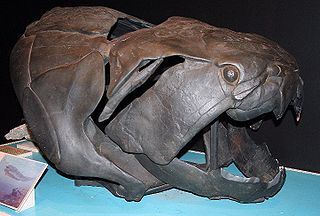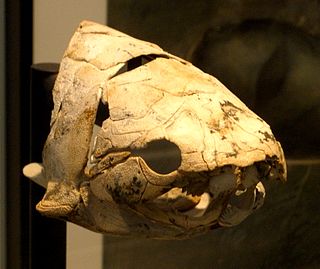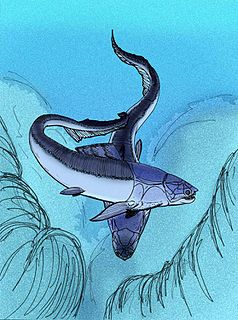
Dinichthys is an extinct monospecific genus of giant, marine arthrodire placoderm from the Late Devonian, comparable in size, shape, and ecological role to the better-known Dunkleosteus. Fossils were recovered from the Ohio Shale Formation along the Olentangy River in Delaware County, Ohio.

Coccosteina is an extinct infraorder of placoderms, armored fish most diverse during the Devonian. However, the term is no longer in use, as modern cladistical methods have produced alternative phylogenetic trees of Brachythoraci with new subdivisions.

Dunkleosteidae is an extinct family of arthrodire placoderms that lived during the Devonian period. The gigantic apex predator Dunkleosteus terrelli is the best known member of this group.

Rolfosteus is an extinct monospecific genus of arthrodire placoderm from the Early Frasnian stage of the Late Devonian period, found at the Gogo Formation of Western Australia.

Eastmanosteus is a fossil genus of dunkleosteid placoderms. It was closely related to the giant Dunkleosteus, but differed from that genus in size, in possessing a distinctive tuberculated bone ornament, a differently shaped nuchal plate and a more zig-zagging course of the sutures of the skull roof.

Plourdosteus is an extinct genus of placoderm arthrodire which was relatively widespread in Euramerica during the Givetian to Frasnian ages of the Devonian.

Mcnamaraspis is an extinct monospecific genus of arthrodire placoderm that inhabited the ancient reef system of north Western Australia during the Frasnian epoch of the Late Devonian period. The type specimen was found and described by John A. Long from the Gogo Formation near Fitzroy Crossing. This fossil fish showed new anatomical features in arthrodires, like the well-preserved annular (ring-shaped) cartilages of the snout, previously inferred to be present by Erik Stensiö of Sweden. It is occasionally referred to as "The Gogo Fish" after the locale the holotype was excavated from.

Aspinothoracidi is a clade of placoderms, extinct armored fish most diverse during the Devonian. The gigantic apex predator Dinichthys, is the best-known member of this group. Many other genera, such as the infamous Dunkleosteus, were previously thought to be close relatives of Dinichthys and were grouped together in the family Dinichthyidae, though more recent studies have restricted that family to only its type species.

Xiangshuiosteus wui is an extinct monospecific genus of brachythoracid arthrodire placoderm from the Late Emsian stage of the Early Devonian epoch, discovered in Wuding County of Yunnan province, China. It has recently been reassessed as a dunkleosteid.

Kiangyousteus is an extinct monotypic genus of dunkleosteid from the Middle Devonian: Givetian aged Guanwu Formation in the Sichuan province of south-western China. The type species, Kiangyousteus yohii, was the first known arthrodire from Asia.

Dunkleosteoidea is an extinct superfamily of arthrodire placoderms that lived during the Devonian period. The gigantic apex predator Dunkleosteus terrelli is the best known member of this group.

Eubrachythoraci is an extinct clade of arthrodire placoderms within the suborder Brachythoraci, armored fish most diverse during the Devonian. Most are considered to be pelagic long-distance swimmers, leading to their widespread distribution beginning from at least the Middle Devonian period.

Pachyosteomorphi is an extinct clade of arthrodire placoderms within the Eubrachythoraci, armored fish most diverse during the Devonian. Most are considered to be pelagic long-distance swimmers, leading to their widespread distribution beginning from at least the Middle Devonian period.
Compagopiscis is an extinct genus of placoderm known from the Gogo Formation. It lived in the Upper Devonian of Western Australia. Compagopiscis is one of the earliest known vertebrates to have teeth. The genus is monotypic, with its only species being Compagopiscis croucheri.
Westralichthys is an extinct monospecific genus of dunkleosteoid from the Late Devonian: Middle Famennian stage from Western Australia.

Panxiosteidae is an extinct family of arthrodire placoderms that lived during the Devonian period.
Panxiosteus is an extinct monospecific genus of placoderm arthrodire from the Middle Devonian: Givetian stage of Yunnan province, China.
Janiosteus is an extinct monospecific genus of placoderm arthrodire from the Middle Devonian: Late Givetian stage found in Timan, Russia.

Coccosteomorphi is an extinct clade of arthrodire placoderms within the Eubrachythoraci, armored fish most diverse during the Devonian. Most are considered to be pelagic long-distance swimmers, leading to their widespread distribution beginning from at least the Middle Devonian period.
Torosteus is an extinct genus of arthrodire placoderm from the Early Frasnian stage of the Late Devonian period. Fossils are found in the Kimberley region of Australia.


















